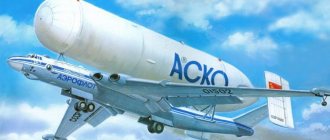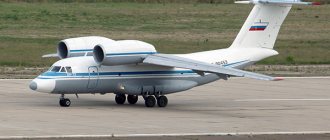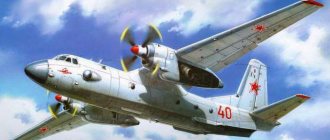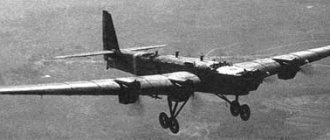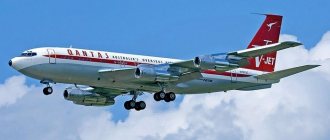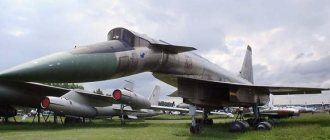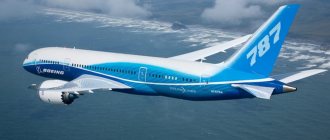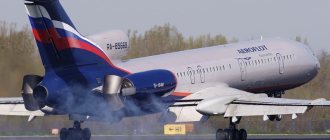The An-124 "Ruslan" military transport aircraft was the largest aircraft in the world (until the appearance of the six-engine An-225 "Mriya" in 1988), and also the leader in terms of payload capacity. The American Boeing 747-8F was able to take the palm only in 2005. The unique design of the cargo compartment, high capacity and reliability allow the vehicle to remain in demand today.
The Ruslan was produced in 1987...2004, it is still in use, the fleet is slowly becoming outdated, and there is no replacement for it yet.
History of creation
Created in 1965, the world's first wide-body army transport aircraft, the An-22 Antey, opened a new page in the rivalry between the USSR and the USA for primacy in the development of high-lift aircraft.
The American response was the Lockheed C-5 Galaxy transport, which was noticeably superior in all characteristics to the An-22. In 1966, a decree of the Central Committee of the CPSU and the Council of Ministers of the USSR was issued on the start of the development of promising aircraft with a payload capacity of at least 100-120 tons.
To develop the new vehicle, it was initially planned to use the Antey fuselage, equipped with a swept wing and turbojet engines. However, the expected characteristics did not suit the customer, and in mid-1968 two new projects were ready, one of which was designated An-124.
After a detailed study of the technical specifications, it was decided to completely rework the concept and design of the machine. The development of blueprints for the Project 400 aircraft began in 1976.
When developing the An-124, the principle of a comprehensive target program was used for the first time, which provided for the joint improvement of all components responsible for the efficiency of the aircraft.
The program contributed not only to accelerating the development of the aircraft, but also to the further development of the Soviet aviation industry.
As a result of complex work, it was possible to reduce fuel consumption by 15% and increase navigation accuracy by 4 times. The labor intensity of servicing the An-124 has decreased several times compared to the Antey.
The construction of the first copies of the machine for static tests was carried out at the KiAPO aircraft plant in Kyiv. Workshops with a span length of up to 100 m were built specifically for the assembly of large-sized An-124 Ruslan aircraft. Turbofan engines lagged behind the aircraft in terms of development.
Bench runs began several months before the planned first takeoff of the An-124. The first prototype was ready at the end of October 1982. Due to the unavailability of the power plant, the aircraft was tested in taxiing mode and short runs.
The first flight of the An-124 took place at the end of December under the control of experienced testers V.I. Tersky and A.V. Galunenko.
The car stayed in the air for about an hour, but during landing the landing gear elements were damaged due to the “shimmy” phenomenon that arose. Further flights revealed the engines' tendency to surge. The defect plagued the An-124 for several years. At the end of 1984, the second test copy of the aircraft was ready.
The official presentation of “Ruslan” took place in the spring of 1985 at the annual aviation show held in France (Le Bourget), and at the end of 1986 the aircraft passed state tests, and entered service with the troops in 1987.
In 1992, the An-124 received an official certificate allowing operation as a civil aircraft. Production of Ruslans was carried out in Kyiv (17 serviceable An-124 aircraft were built) and Ulyanovsk (33 aircraft were assembled).
Over the years of operation, four aircraft were lost in accidents, including the crash of the second test copy of the An-124. The plane crashed during test flights aimed at obtaining a civil airliner certificate.
The biggest disaster involving the An-124 was the crash of a car with tail number RA-82005 into residential areas in Irkutsk. The cause of the disaster, which claimed the lives of 72 people, was overload and surging of the engines due to gross violations of maintenance standards.
First flights and records
The An-124 model made its very first flight in Kyiv on December 21, 1982. The crew, headed by V. I. Tersky, included: test pilot A. V. Galunenko, navigator A. P. Poddubny, flight engineers V. M. Vorotnikov and A. M. Shuleschenko, as well as flight radio operator M. A. Tupchienko . V. S. Mikhailov and M. G. Kharchenko acted as leading testing engineers. After successful testing of the machine, its serial production began.
In 1985, the airliner set 21 world records. Their list included an achievement in such a parameter as lifting capacity (a weight of 171,219 kg was raised to a height of 2 thousand meters). In the same year, the ship was demonstrated to the world community. This happened during an air exhibition in Paris. Two years later, the aircraft appeared in service with the Soviet Army. Reviews from pilots and testers characterized it as a reliable airliner, which is distinguished by precise control and navigation systems. In addition, experts noted the high load capacity and fast loading and unloading.
Design
The all-metal fuselage of the An-124 aircraft is made according to the standard design for army transport vehicles with an upper swept wing. The tail unit is built according to a single-fin design. Composite materials were used in the manufacture of the fuselage and wing load-bearing kit.
The total weight of materials in the structure is 5000 kg.
Using this solution made it possible to reduce the weight of the empty machine by 2000 kg. The power structure of the fuselage is made up of transverse frames connected by longitudinal stringers and spars. The design uses working skin, which further increases the strength of the fuselage.
The 28⁰ swept wing has a high aspect ratio and a thick profile. The An-124 wing structure has four spars, the consoles are one-piece. The wing consists of three segments - nose, caisson and rear. The caisson is part of the aircraft's load-bearing structure and has a longitudinal and transverse strength set.
The mechanization of the control units consists of six sections of slats, which are installed along the nose of the wing along the entire span. At the rear of each console there is an internal flap and two additional sections of slotted flaps. Next to the flaps there are two ailerons and 12 sections of brake flaps.
The vertical tail of the An-124 aircraft consists of a fin and a rudder mounted on it. The steering wheel is divided into upper and lower sections. The keel is built according to a design with two spars and working skin. Horizontal stabilizers are made according to a similar design. The elevators, located on the rear of the stabilizer, consist of two elements - internal and external.
The An-124 fuselage has a profile in the form of two circles intersecting in the form of the number “8”, and is equipped with two decks inside. The radius of the upper circle is 1900 mm, the bottom – 3800 mm. The load-bearing frame and the casing are connected by welding and glue.
Some of the fuselage elements are made of carbon fiber, in particular the rear cargo hatch flaps.
Transverse sealed bulkheads divide the An-124 fuselage into several compartments. Sealing protects the underfloor compartments of the fuselage from flooding with rainwater and from the ingress of aggressive liquids (during transportation). The fuselage is equipped with a system of drainage holes to prevent fluid stagnation and corrosion. The upper front part is used to accommodate crew members (main and replacement).
Each An-124 crew consists of 6 people:
- crew commander;
- assistant commander;
- navigator;
- senior onboard engineer;
- flight engineer;
- radio station operator.
In addition to the personnel, the replacement crew compartment houses various flight equipment and life support systems. The equipment allows landing troops and delivering cargo at different times of the day under different meteorological conditions, as well as when countering enemy air defense systems.
The An-124 equipment includes a flight system with sighting and navigation units, a radio communication system, and special equipment for landing.
The An-124 cockpit is equipped with glazing attached to the cockpit frame. The replacement crew compartment has three round glazed windows facing to the side. Additional windows are made in the cargo compartment. They are designed to visually monitor the condition of engines and cargo compartment doors.
In the lower front part of the fuselage there is a cargo compartment adapted to accommodate military equipment.
The compartment runs along the entire length of the fuselage and is equipped with cargo hatches located in the forward and aft parts of the fuselage. The hatch openings are equipped with reinforcements. The useful volume of the compartment is 1050 m³. For loading and unloading, the An-124 aircraft is equipped with standard crane and mooring equipment.
The compartment contains two mobile cranes with a lifting capacity of 10 tons. Bridge-type units move on rails installed along the sides. Additionally, electric winches are installed, developing a traction force of up to 4500 kg. The lower deck equipment allows for the transportation of single cargo weighing up to 50 tons.
The section of the upper deck, located in the rear section, is intended to accommodate maintenance and accompanying personnel. The An-124 aircraft could accommodate up to 22 passengers. In most cases, the maintenance team consisted of two operators operating standard overhead cranes.
The personnel cabin is equipped with a pressure support system that allows flights at altitudes up to 8000 m without the use of oxygen masks.
The chassis is equipped with twelve supports. Of these, two are located at the front, and ten are located on the sides of the fuselage (five per side). All racks have two wheels and are equipped with individual independent suspension and a separate cleaning mechanism.
The front support does not have braking mechanisms, is equipped with a turning mechanism and allows the An-124 aircraft to turn on a runway 50 meters wide.
In this case, an asymmetric operating mode of the engines is used, which makes it possible to reduce the turning radius.
The landing gear doors of the An-124 are made of composite material to reduce weight. The main rack trolleys are equipped with a ground clearance adjustment system, which reduces the ramp inclination and simplifies loading and unloading. Structurally, the aircraft is designed for operation from runways longer than 3000 m, equipped with a concrete surface. In practice, the machines were successfully used from unpaved airfields.
The power plant includes four turbofan engines of the D-18T model. The installations were developed at the Zaporozhye design bureau "Progress" specifically for the An-124 and the even larger An-225 transport aircraft.
The engine is created according to a three-shaft design and consists of a compressor fan and two working rotors (low and high pressure). The design of the turbojet engine provides a high bypass ratio - up to 80%. The engines are located under the wing, on pylons. Additional TA-12 gas turbines are mounted in the chassis fairings.
The engine nacelles of the An-124 aircraft contain a pre-air preparation system for air conditioning systems in the cabins, as well as for the operation of the anti-icing system. Air is taken from the compressor, then it is cooled and supplied to the actuators under normal pressure.
The hydraulics of the An-124 aircraft operate from pumping units located on the engines. The units consist of two separate pumps.
Each system is autonomous and can provide fluid to all actuators.
Hydraulics operate the rudder system for controlling the aircraft, the extension and retraction of the landing gear, the flap drives, the braking and wheel control system, and the cargo hatch drives.
The electrical network of the An-124 is designed for alternating voltages of 115 and 200 V. The generating sets are located on turbofan engines and have a total power of 240 kVA. The fuel supply is located in the center section caissons.
There are 13 separate fuel tanks divided into 4 output stages. Gradual development allows you to maintain the alignment of the aircraft. The weight of fuel in tanks is up to 213 thousand kg.
Fuselage
The An-124 Ruslan airliner has a fuselage consisting of two decks. This is done to facilitate repair and maintenance. Each of them is divided into separate, sealed compartments that have a specialized purpose. The main and replacement crews are located on the upper front deck, and the people who accompany cargo and equipment are in the upper rear compartment (it is designed for 80 people). It should be noted that due to the pressurization system inside, a pressure drop is ensured that does not exceed 25 kPa. Thanks to this, passengers can stay at altitudes of up to 8,000 meters without oxygen equipment.
Technical characteristics of An-124
| Parameter | Meaning |
| Fuselage length, m | 69,1 |
| Midsection diameter, m | 7,68 |
| Cargo deck length, m | 43,45 |
| Cargo deck width, m | 6,68 |
| Cargo compartment height, m | 4,4 |
| Wingspan, m | 73,3 |
| Wing area, m² | 628 |
| Horizontal tail area, m² | 166,7 |
| Elevator area, m² | 49,75 |
| Chassis track, m | 8 |
| Maximum taxiing weight, kg | 398 000 |
| Maximum take-off weight, kg | 392 000 |
| Maximum landing weight, kg | 330 000 |
| Maximum speed, km/h | 530 |
| Takeoff length (depending on mass), m | 1000-2200 |
Loading and unloading
The loading and unloading processes in this model are carried out quite quickly. In addition to the rear hatch, the vessel has a folding bow, which allows you to quickly work with non-standard, long and large cargo. The length without ramp, width and height of the cargo compartment are 26.5, 6.4 and 4.4 meters respectively. Thus, its total volume is more than 1000 cubic meters. Due to the fact that the floor is made of high-strength titanium alloy, it becomes possible to load all types of self-propelled and non-self-propelled equipment on crawler tracks. The lifting capacity of each of the onboard cranes with which the machine is equipped is 10 tons. In addition, the designers installed electric mobile floor winches in it.
An-124 modifications
On the basis of the army An-124, a commercial version with the index 124-100 was created in 1992. The machine passed a cycle of certification checks and was found to meet the requirements.
Based on the 100 model, a modernized version was created under the designation An-124-100M. The aircraft used flight and navigation equipment manufactured in the CIS countries and Europe. The equipment made it possible to reduce the crew to four people and increase operational safety. To reduce noise, the engine nacelles are equipped with hoods with noise-absorbing elements.
Another option was the An-124-100M-150, featuring an increased payload of up to 150,000 kg and an extended range. With a load weighing 120,000 kg, the aircraft has a range of 5,400 km.
Major disaster
During the entire period of operation, several tragic accidents occurred with aircraft of this brand. The largest of them happened on December 6, 1997 at 14.40, when the Russian Air Force An-124 Ruslan airliner crashed near the construction village of Irkutsk-2. The result of the plane crash was the death of seventeen crew members and six workers of the Irkutsk aircraft plant. In addition to them, death overtook 72 residents of the town. The fact is that approximately 25 seconds after takeoff, the airliner crashed onto a four-story residential building, completely destroying it. During the investigation of the tragedy, the “black boxes” were deciphered. The investigation established that the cause of the accident was engine shutdown, which occurred as a result of a malfunction of the on-board computer.
Interesting Facts
Several names were proposed for the name of the aircraft, including “Taras Bulba”. The name "Ruslan" was proposed by O.K. Antonov, among others, borrowed from Greek mythology.
In 1985...87, a number of world aviation records were set on An-124 aircraft.
During a non-stop flight with a total length of 20,151 km, passing along the borders of the Soviet Union, the take-off weight of the vehicle reached 455,000 kg.
When creating the An-124 aircraft, it was planned to accommodate on board a landing force consisting of 440 paratroopers or 880 infantry soldiers, equipped with full combat equipment. During the tests, landing of dummies was used.
Test landings revealed a number of restrictions on landing people through the tail hatch in the fuselage. One of the vehicles was equipped with additional doors on the sides of the fuselage, intended for landing. This modification was carried out on one An-124 “Ruslan”; the rest of the aircraft did not have doors.
Exploitation
At the very beginning of 1986, the active use of An-124 Ruslan airliners began. It was mainly operated on Siberian airlines, where it satisfied the state's need for the transportation of large cargo for oil and gas developments. In addition, the ship was actively used for military purposes. For example, it transported the Patriot anti-aircraft missile system during combat operations in Afghanistan. In September 1990, Ruslan managed to transport 451 refugees on the Amman-Dhaka route in one flight. Then the liner was additionally equipped with a 570-liter drinking water tank and toilet blocks with a chemical regeneration function. To accommodate passengers in a horizontal position, the cabin was covered with sponge rubber.
Prospects
Production of An-124 aircraft ended at the plant in Ulyanovsk in 2004. In Kyiv, the assembly ended even earlier. In total, the factories shipped 56 machines to customers. Some of the vehicles in service with the Russian army have undergone modernization with the replacement of airframe structural elements and radio navigation equipment. The modified aircraft comply with the An-124-100M specification.
The problem of further modernization was the aggravated relationship between Russia and Ukraine.
The Antonov Design Bureau, located in Ukraine, periodically publishes materials about the planned ban on Ruslan flights outside Russia if service is refused.
The Russian armed forces operate 24 An-124 aircraft. Another 12 vehicles are used in transport aircraft. There are 7 machines in Ukraine. According to separate data, one aircraft from the Libyan civil aviation fleet is located in Kyiv and Tripoli.
One machine each is used in aviation in the United Arab Emirates and Azerbaijan. The car is used by the UN on a rental basis. If necessary, the organization can attract up to six An-124 Ruslan aircraft for cargo transportation or rescue operations.
Chassis
An-124 is an aircraft whose chassis is equipped with a set of devices that provide the ability to squat. This allows you to significantly reduce the slope of the ramps. Each of the main landing gear consists of five two-wheeled struts, which are independent of each other. As for the front support, it consists of two struts (also with two wheels in each). Thanks to the presence of a turning mechanism control system, the airliner is able to turn around on a runway whose width is 50 meters. At the same time, to ensure full use of the vessel’s capabilities, it must be operated on strips with a concrete surface and a length of at least three kilometers. Be that as it may, it was already noted above that under certain conditions the airliner can take off and land on a ground surface.
